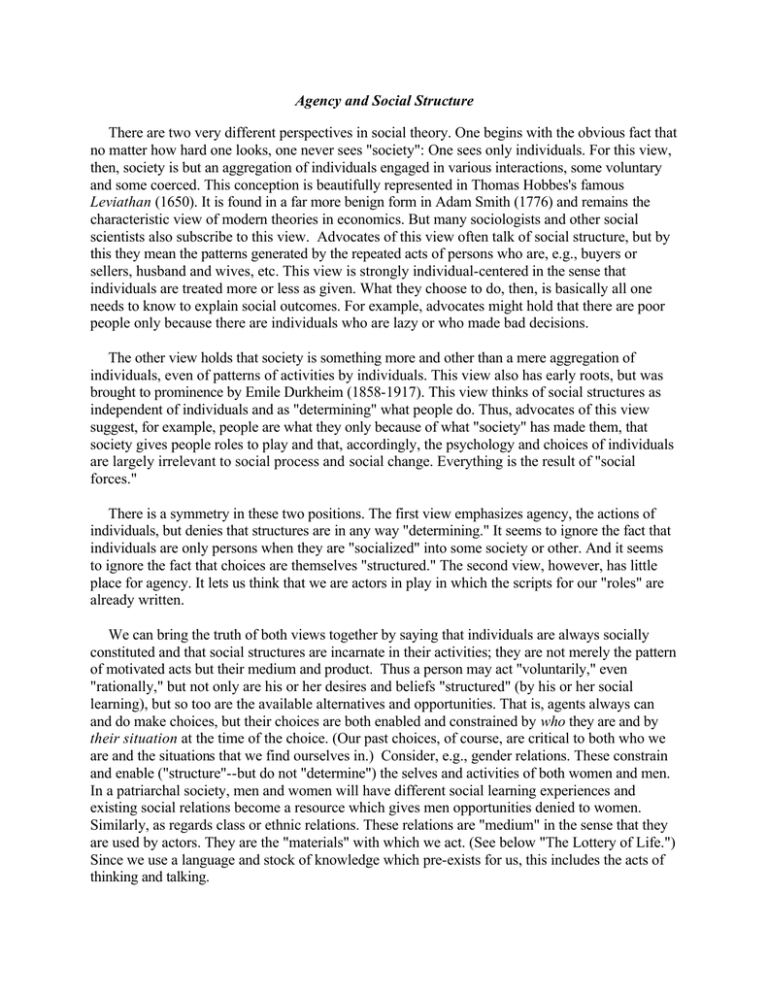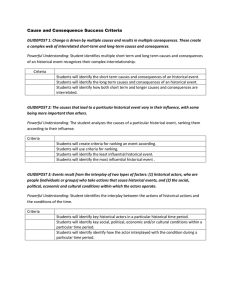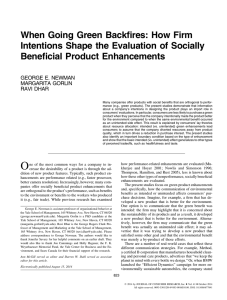Agency and Social Structure There are two very different
advertisement

Agency and Social Structure There are two very different perspectives in social theory. One begins with the obvious fact that no matter how hard one looks, one never sees "society": One sees only individuals. For this view, then, society is but an aggregation of individuals engaged in various interactions, some voluntary and some coerced. This conception is beautifully represented in Thomas Hobbes's famous Leviathan (1650). It is found in a far more benign form in Adam Smith (1776) and remains the characteristic view of modern theories in economics. But many sociologists and other social scientists also subscribe to this view. Advocates of this view often talk of social structure, but by this they mean the patterns generated by the repeated acts of persons who are, e.g., buyers or sellers, husband and wives, etc. This view is strongly individual-centered in the sense that individuals are treated more or less as given. What they choose to do, then, is basically all one needs to know to explain social outcomes. For example, advocates might hold that there are poor people only because there are individuals who are lazy or who made bad decisions. The other view holds that society is something more and other than a mere aggregation of individuals, even of patterns of activities by individuals. This view also has early roots, but was brought to prominence by Emile Durkheim (1858-1917). This view thinks of social structures as independent of individuals and as "determining" what people do. Thus, advocates of this view suggest, for example, people are what they only because of what "society" has made them, that society gives people roles to play and that, accordingly, the psychology and choices of individuals are largely irrelevant to social process and social change. Everything is the result of "social forces." There is a symmetry in these two positions. The first view emphasizes agency, the actions of individuals, but denies that structures are in any way "determining." It seems to ignore the fact that individuals are only persons when they are "socialized" into some society or other. And it seems to ignore the fact that choices are themselves "structured." The second view, however, has little place for agency. It lets us think that we are actors in play in which the scripts for our "roles" are already written. We can bring the truth of both views together by saying that individuals are always socially constituted and that social structures are incarnate in their activities; they are not merely the pattern of motivated acts but their medium and product. Thus a person may act "voluntarily," even "rationally," but not only are his or her desires and beliefs "structured" (by his or her social learning), but so too are the available alternatives and opportunities. That is, agents always can and do make choices, but their choices are both enabled and constrained by who they are and by their situation at the time of the choice. (Our past choices, of course, are critical to both who we are and the situations that we find ourselves in.) Consider, e.g., gender relations. These constrain and enable ("structure"--but do not "determine") the selves and activities of both women and men. In a patriarchal society, men and women will have different social learning experiences and existing social relations become a resource which gives men opportunities denied to women. Similarly, as regards class or ethnic relations. These relations are "medium" in the sense that they are used by actors. They are the "materials" with which we act. (See below "The Lottery of Life.") Since we use a language and stock of knowledge which pre-exists for us, this includes the acts of thinking and talking. Since everyone is born into some society, social structures do pre-exist for individuals; but they do not exist independently of what we do; they are produced in that they are reproduced by our actions: they continue to exist only because they are incarnate in our activities. In writing this, without intending it, I reproduce a structure, the English language. It is thus that they are the "product" of what we do. But notice that by doing things differently, at home, at work, etc., we do also transform structures. (Thus, we change the language by introducing new terms, by speaking ungrammatically, etc.) Since there is some novelty in every act (and interaction), changes in social structure are not usually intended. Indeed, even when people act to make changes, the intended changes are not what generally occur. Thus, people may become aware of a prevailing structure and struggle to change it. But even then, the outcomes of what they do have unintended consequences. For example, successful union struggles in Hawai'i contributed to unintended changes in Hawaii's economy. Indeed, we can think of social process, including social change, as the unintended reproduction and transformation of social structure and we can think of history as the product of joint activities of all the people who preceded us. This view helps us to see the importance of history. Because people make history, but with differing materials not of their own choosing, societies are different and they change.

